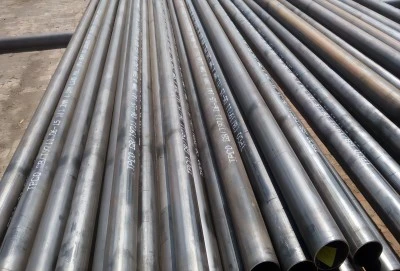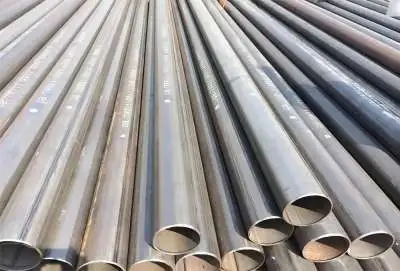High-frequency welded (HFW) steel pipes are crucial components in various industries, known for their durability, efficiency, and versatility. As a leading manufacturer of ERW/LSAW steel pipes, Longma Group understands the importance of selecting the right HFW steel pipe sizes for different applications.
|
|
|
What are the Common Diameter and Wall Thickness Options for HFW Steel Pipes?
HFW steel pipes are available in a wide range of sizes to accommodate diverse project requirements. The most common diameter and wall thickness options include:
1.Diameter Options:
HFW steel pipes are typically produced in diameters ranging from 1/8 inch (3.2 mm) to 26 inches (660 mm). Some of the most frequently used diameter ranges include:
- Small Diameter: 1/8 inch to 2 inches (3.2 mm to 50.8 mm)
- Medium Diameter: 2 inches to 10 inches (50.8 mm to 254 mm)
- Large Diameter: 10 inches to 26 inches (254 mm to 660 mm)
2.Wall Thickness Options:
The wall thickness of HFW steel pipes is often expressed in terms of schedule numbers or specific measurements. Common wall thickness options include:
- Schedule 10 (Thin Wall)
- Schedule 40 (Standard Wall)
- Schedule 80 (Extra Strong)
- Schedule 160 (Double Extra Strong)
Wall thickness can range from as thin as 0.065 inches (1.65 mm) for small diameter pipes to over 0.5 inches (12.7 mm) for larger diameters.
It's important to note that the availability of specific size combinations may vary depending on the manufacturer and industry standards. Longma Group offers a comprehensive range of HFW steel pipe sizes to meet diverse project needs.
What Factors Determine the Size Selection of HFW Steel Pipes?
Selecting the appropriate size for HFW steel pipes is crucial for ensuring optimal performance and longevity in various applications. Several factors influence the size selection process:
1. Intended Application: The specific use of the pipe is a primary factor in determining its size. For example, pipes used for high-pressure applications may require thicker walls, while those used for low-pressure fluid transport might use thinner walls.
2. Operating Pressure: The internal pressure that the pipe will be subjected to plays a significant role in size selection. Higher operating pressures generally require pipes with thicker walls to ensure structural integrity and safety.
3. Flow Rate Requirements: The volume of fluid or gas that needs to be transported through the pipe influences the diameter selection. Larger diameters can accommodate higher flow rates, while smaller diameters are suitable for lower flow rates.
4. Material Properties: The grade of steel used in the HFW pipe affects its strength and corrosion resistance. Higher-grade steels may allow for thinner wall thicknesses while maintaining the required strength.
5. Environmental Factors: External conditions such as temperature, humidity, and exposure to corrosive substances can impact the required wall thickness and overall pipe size.
6. Industry Standards and Regulations: Different industries have specific standards and regulations that dictate the acceptable pipe sizes for various applications. Compliance with these standards is essential for safety and regulatory reasons.
7. Cost Considerations: While not a technical factor, the cost of different pipe sizes can influence selection, especially for large-scale projects. Balancing performance requirements with budget constraints is often necessary.
8. Installation and Maintenance: The ease of installation and future maintenance needs may impact size selection. Larger pipes may be more challenging to install in confined spaces but could offer easier access for maintenance.
9. Weight and Support Requirements: The weight of the pipe, especially when filled with fluid, affects the support structures needed. This can be a crucial factor in structural applications or when retrofitting existing systems.
10. Thermal Expansion: In applications involving significant temperature changes, the potential for thermal expansion must be considered. This can affect both diameter and wall thickness choices.
By carefully considering these factors, engineers and project managers can make informed decisions when selecting HFW steel pipe sizes. Longma Group's expertise in steel pipe manufacturing allows us to provide guidance and recommendations tailored to specific project requirements.
What are the Industry Applications of Different HFW Steel Pipe Sizes?
HFW steel pipes find applications across numerous industries, with different sizes suited for specific uses. Here's an overview of how various HFW steel pipe sizes are utilized in different sectors:
Oil and Gas Industry:
- Small to Medium Diameters (1/2" to 6"): Used for wellhead piping, gathering lines, and instrumentation tubing.
- Medium to Large Diameters (8" to 24"): Employed in flow lines, transmission pipelines, and processing plant piping.
Construction and Infrastructure:
- Small Diameters (1/2" to 2"): Commonly used in residential plumbing and HVAC systems.
- Medium Diameters (3" to 10"): Utilized in commercial building water supply, fire sprinkler systems, and structural supports.
- Large Diameters (12" to 24"): Applied in municipal water distribution, sewage systems, and large-scale irrigation projects.
Manufacturing and Industrial Processes:
- Small to Medium Diameters (1" to 6"): Used in process piping for chemical plants, food processing facilities, and pharmaceutical manufacturing.
- Medium to Large Diameters (8" to 20"): Employed in cooling water systems, steam distribution, and material handling in heavy industries.
Automotive Industry:
- Small Diameters (1/4" to 2"): Used in fuel lines, brake lines, and exhaust systems.
- Medium Diameters (2" to 6"): Applied in truck and bus chassis components and structural reinforcements.
Agriculture:
- Small to Medium Diameters (1" to 6"): Utilized in irrigation systems, livestock watering, and greenhouse structures.
- Large Diameters (8" to 24"): Used in main irrigation lines and water storage systems.
Energy Sector:
- Medium to Large Diameters (6" to 24"): Applied in power plant cooling systems, hydroelectric penstocks, and geothermal energy projects.
Marine and Offshore:
- Small to Medium Diameters (1/2" to 8"): Used in shipbuilding for various piping systems including ballast, fuel, and hydraulic lines.
- Large Diameters (10" to 24"): Employed in offshore platform risers and subsea pipelines.
Furniture and Equipment Manufacturing:
- Small Diameters (1/2" to 2"): Used in the production of metal furniture, playground equipment, and exercise machines.
Mining:
- Medium to Large Diameters (4" to 24"): Applied in slurry transportation, dewatering systems, and ventilation ducts in underground mines.
The versatility of HFW steel pipes across these industries demonstrates their importance in modern infrastructure and industrial processes. Longma Group's extensive range of HFW steel pipe sizes ensures that we can meet the diverse needs of these various sectors, providing high-quality products that contribute to the efficiency and reliability of countless applications worldwide.
Contact Longma Group
HFW steel pipes play a crucial role in numerous industries, offering a balance of strength, durability, and cost-effectiveness. The wide range of available sizes, from small-diameter pipes used in residential plumbing to large-diameter pipes employed in major infrastructure projects, underscores the versatility of this product. By understanding the factors that influence size selection and the specific applications across different industries, project managers and engineers can make informed decisions to ensure optimal performance and longevity of their piping systems.
As a leading manufacturer of ERW/LSAW steel pipes, Longma Group is committed to providing high-quality HFW steel pipes that meet the diverse needs of our clients across various sectors. Our expertise in steel pipe manufacturing, combined with our comprehensive range of sizes and specifications, positions us as a reliable partner for your project needs.
If you're looking for top-quality HFW pipes or need assistance in selecting the right size for your application, don't hesitate to reach out to our team of experts. Contact us at info@longma-group.com for personalized support and to learn more about how Longma Group can contribute to the success of your projects.














